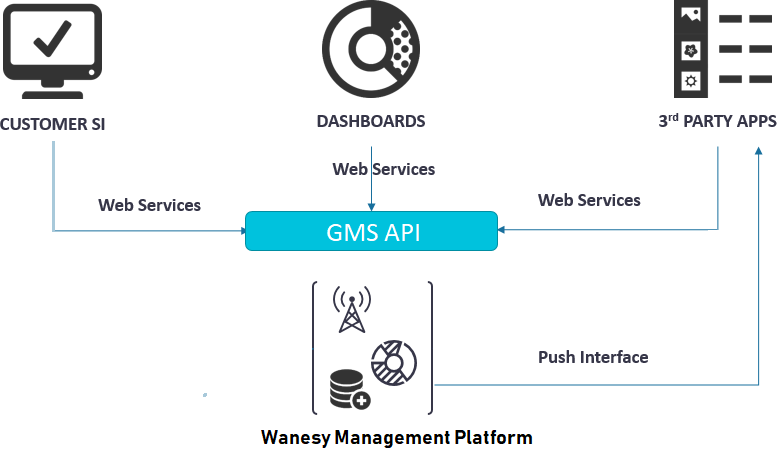Table of Contents
GMS
REST
A RESTful Web services architecture follows basic design principles:
- It exposes a tree of resources via URI
- It is stateless. Each request from any client contains all the information necessary to service the request, and session state is held in the client.
- A resource is represented by an hypermedia type, for example JSON
- It uses HTTP methods explicitly (
GET,POST,PUT,DELETE, …) and other HTTP standards - hypertext links to reference state
- hypertext links to reference-related resources
The API version level is requested by the client using the accept HTTP header, for example here with API v1:
Accept: application/vnd.kerlink.iot-v1+json
Refer to the Documentation section to get details of all methods available for this new WMC release.
Example
GET https://kerlink.wanesy.fr/gms/application/customers/198/fleets?page=3&PageSize=40
This web service allows to get the page number 3 of the list of fleets of the customer 198.
| VERB | PROTOCOL | DOMAIN | PATH | QUERY STRING |
| GET | http | kerlink.wanesy.fr | /gms/application/customers/1/fleets | ?page=3&PageSize=40 |
The list of possible verbs is : GET, POST, PUT, DELETE, PATCH
POST: creates a new resource.GET: gets a resource.PUT: updates an existing resource.DELETE: deletes a resource.PATCH: updates a subset of fields of an existing resource.
Using the command-line
These examples use the command-line program curl to make HTTP requests.
Logging in
The use of the API is bound to a fresh token. Here is how you can request for a new token:
curl -s 'https://kerlink.wanesy.fr/gms/application/login' \ -H 'Accept: application/vnd.kerlink.iot-v1+json' \ -X POST \ -d '{"login":"jdoe","password":"P@ssW0rd5ecRe7"}' \ -H 'Content-Type: application/vnd.kerlink.iot-v1+json' \ | jq .
Here jq is used to prettify the JSON output so that it is readable and indented:
{ "expiredDate": 1500537180050, "tokenType": "Bearer", "token": "eyJhbGciOiJIUzI1NiJ9.eyJzdWIiOiJzdXBlcmFkbW ... n6i5WboHR-I" }
Requesting the customers list
curl -s 'https://kerlink.wanesy.fr/gms/application/customers' \ -H 'Accept: application/vnd.kerlink.iot-v1+json' \ -H 'Authorization: Bearer eyJhbGciOiJIUzI1NiJ9.eyJzdWIiOiJzdXBlcmFkbW ... n6i5WboHR-I' \ | jq .
Result:
{ "count": 2, "pageSize": 50, "page": 1, "totalCount": 2, "list": [ { "id": 130, ... } ], "nbPages": 1 }
Requesting the customer ID
$ curl -s 'https://kerlink.wanesy.fr/gms/application/authenticatedUser' \ -H 'Authorization: Bearer eyJhbGciOiJIUzI1NiJ9.eyJzdWIiOiJzdXBlcmFkbW ... n6i5WboHR-I' \ -H 'Content-Type: application/vnd.kerlink.iot-v1+json;charset=UTF-8' \ -H 'Accept: application/json, text/plain, */*' \ | jq '.links[] | select(.rel=="customer") | .href'
The jq filter is used to show only customer ID information. In fact, it will display the href value for all links objects for which the rel key has the customer value.
Example result with customer ID number 23:
"/application/customers/23"
Sending data to an endpoint
Not all fields in TxMessageDto are required when creating a new TX message. The actual parameters to send are:
confirmed: boolean, whether the TX message should be acknowledged (confirmed data transfer)contentType: enum { TEXT, HEXA }, describes how the payload is encodedport: integer, LoRaWAN application port numberpayload: string, data payload, either encoded as an hex string or binary data in base64maxAttempts: integer (optional), maximum number of transmission attempts. Only required if confirmed is true.ttl: integer (optional), time to live. Only required if confirmed is true.
No other parameter is supported.
